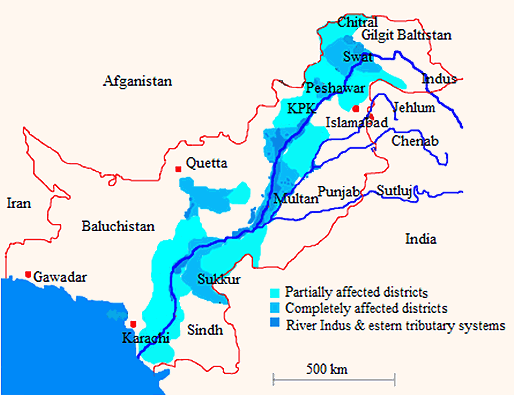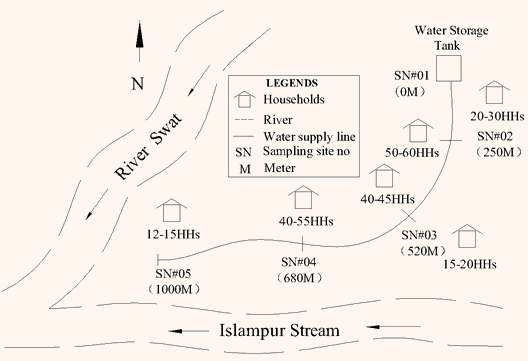Introduction
Contaminated drinking water is a major source of pathogenic organisms; the microbial pollution of a water supply presents a threat to human safety1,2. Pathogens are transmitted to water from the feces of warm blooded animals and some reptiles. The bacterium Escherichia Coli (E. coli) is a key fecal indicator organism for the presence of other pathogenic organisms in drinking water3,4.
Water contamination in Pakistan is of particular concern. Currently, almost half of Pakistan's population has no access to clean potable water5. Approximately 70% of Pakistan's surface and sub-surface water supply sources are not fit for drinking due to heavy organic, inorganic and biological contamination6,7. In recent years Pakistan has faced catastrophic natural disasters, notably the 2005 earthquake and 2010 floods. In the aftermath of the 2010 floods, the water quality monitoring reports of many organizations (Oxfam, Lasoona and Water Aid) indicated the presence of pathogenic organisms in drinking water in Swat (northern Pakistan).
The UK based humanitarian organization Oxfam intervened in northern Pakistan after the 2010 floods to rehabilitate the damaged community water and sanitation schemes. At that time the Pakistan Health Department had registered many gastrointestinal and diarrheal cases due to the destruction of the WASH (Water, Sanitation and Hygiene) infrastructures and the consequent threats to public health (Executive District Officer Swat; pers.comm; 2010).
The aims of this study were to: (i) assess damaged community water and sanitation systems in the priority area of concern during the 2010 emergency; and (ii) assess the drinking water quality by analyzing some important physio-chemical and biological parameters.
Geographical setting and sampling sites
Districts affected by the 2010 flood, and the eastern rivers tributary system of Pakistan are shown (Fig1). District Swat was among the most severely affected areas. Marghazar town is located at the hub of Swat River and the Islampur Stream of Swat in northern Pakistan (Fig2). Because of its proximity to these rivers and its low lying topography, this town was severely affected by the 2010 floods and many houses, water and environmental sanitation infrastructure were washed away. Five sites were selected for water sampling and testing in the Marghazar town water supply system (Fig 2).

Figure 1: Map of Pakistan showing flood affected regions and the eastern rivers network8.

Figure 2: Schematic map of Marghazar's town showing the population distribution and water sampling sites.
Analytical methods
A portable testing kit (University of Surrey, UK) was used to assess the microbiological quality of drinking water using methyl lauryl sulphate broth media with standard procedures adopted by Fewtrell & Bartram9. Microbial organisms can be measured as colony forming units (CFU) using a plate counting method10. Turbidity, pH, conductivity and total dissolved solids (TDS) were checked using respective portable meters (Wagtech International, UK). Total hardness as calcium carbonate and nitrate as NO3-2 were measured using a Photometer (WAG-WE10441; Wagtech International, UK) at 420 nm wave length. Statistical analysis was performed by taking the mean of three time-assessed values and applying the standard deviation to the data.
Total plate counts in the drinking water samples ranged from 18 to 96 ± 7 cfu/100 mL, whereas the WHO permissible limit is 0 cfu/100 mL per water sample in ideal conditions. Sample numbers 04 and 05 had higher plate counts of E. coli with 84 ± 3 and 96 ± 4 cfu, respectively. Similarly, in samples from SN02 and 03 large counts of E. coli were recorded: 18 ± 2.02 and 62 ± 2.43, respectively. Other coliform groups such as Shigella, Salmonella, Staphylococcus aureus were also present at all sampling sites except SN01, which indicated that all water samples from consumer points were highly contaminated (Table 1).
Selectively tested physio-chemical parameters (pH, turbidity, conductivity, TDS, total hardness as CaCO3 [mg/L] and nitrate as NO3-2 [mg/L]) at all the five sampling sites were within the WHO permissible limits, but turbidity at sampling sites SN04 and 05 was just above the standard and located 680 m from the water storage tank (WST; Table 2). Moreover, slight variations in physio-chemical parameters were recorded in Marghazar town main WST at SN01 to 05.
Table 1: Results of microbiological examination of water samples in different samplings sites

Table 2: Results of physio-chemical examination of water samples in different sampling sites

Discussion
According to WHO, public health risk categories are 0 cfu/100 mL (conformity); 1-10 cfu/100 mL (low risk); 10-100 cfu/100 mL (intermediate risk); 100-1000 cfu/100 mL (high risk), and >1000 cfu/100 mL (very high risk)11. The present microbial assessment results (Table 1) indicate that Marghazar town's water supply network was at a WHO-categorized intermediate risk with bacterial contents recorded at 10-100 cfu/100 mL, and this could have caused the hospitalization of many people. Drinking water quality at differing risks-levels was also reported in disasters such as the Indian Ocean tsunami 200412, the Kashmir (Pakistan) earthquake 200513 and the Haiti earthquake 20106.
Microbiologically contaminated potable water has a direct effect on public health and poses a severe threat to human beings with continued usage. According to WHO more than 80% of communicable human diseases are water borne11. Water quality results of E. coli, Shigella, Salmonella and Staphylococcus aureus in Marghazar samples demonstrate the incident caused the intrusion of sewage water from the open drain sanitation system into the drinking water supply network. During the emergency this might have been a source of diseases such as typhoid fever, cholera, dysentery, food poisoning, gastroenteritis, diarrhea and ameobiasis14. Household visits revealed that health was not the householders' priority area of concern at the time of the emergency as they had other pressing needs. Consequently, people were not concerned about the poor quality of drinking water due to flood pollution.
Physio-chemical parameters were within permissible limits of WHO and US-EPA, except for turbidity. Turbidity was found to be higher towards the end of the water supply system (SN04 & 05) because silt containing sewage water had leaked from the joints of the water distribution line. Disinfectants, for example chlorine and ozone among others, cannot completely kill pathogens in drinking water containing turbidity2 as some microorganisms produce cysts to overcome the disinfection process15. Hence, the higher pathogen concentrations recorded in Marghazar town's WSS indicate a need for a treatment system that simultaneously removes both pathogenic organisms and turbidity. Mahmood Q et al and Baig et al have developed and experimentally tested household biosand with innovative adsorbent materials to remove both pathogens and turbidity6,7. This was pilot tested after the 2005 earthquake in the same geographical region. Implementation of the same household treatment in Marghazar town could have solved the water quality issue.
The water quality results suggested that the hospitalization of Marghazar town residents reported was due to their drinking contaminated water from an existing, damaged water supply system. Regular monitoring of drinking water quality and the promotion of hygienic household behavior during an emergency response is highly recommended.
Acknowledgements
The authors extend their appreciation to the European Commission Humanitarian Office (ECHO) and Oxfam GB Pakistan for their joint financial support. Also acknowledged is Professor Ashton Shortridge of Michigan State University, USA.
References
1. Duke WF, Nordin RN, Baker D, Mazumder A. The use and performance of Biosand filters in the Artibonite Valley of Haiti: A field study of 107 households. Rural and Remote Health 2006; 6(3): 570. (Online) 2006. Available: www.rrh.org.au (Accessed 4 September 2012).
2. Ashbolt NJ. Microbial contamination of drinking water and diseases outcomes in developing region. Toxicology 2004; 198(1-3): 229-238.
3. Edberg SC, Rice EW, Karlin RJ, Allen MJ. Escherichia coli: the best biological drinking water indicator for public health protection. Journal of Applied Microbiological Symtoms 2000b; 88: 106-116.
4. Whelan JJ, Willis K. Problems with provision: barriers to drinking water quality and public health in rural Tasmania. Rural and Remote Health 2006; 7: 627. (Online) 2007. Available: www.rrh.org.au (Accessed 4 September 2012).
5. Government of Pakistan. National water quality report. PCRWR. Pakistan: Ministry of Science and Technology Islamabad, 2006a.
6. Mahmood Q, Baig SA, Nawab B, Shafqat MN, Pervez A, Saima B. Development of the low cost household drinking water treatment system for the earthquake affected community in northern Pakistan. Desalination 2011; 273: 316-320.
7. Baig SA, Mahmood Q, Nawab B, Shafqat MN, Pervez A. Improvement of drinking water quality by using of plant biomass through household biosand filter-A decentralized approach. Ecological Engineering 2011; 37: 1842-1848.
8. Shams AB, Xinhua X, Naveedullah, Niaz M, ZiaUllah K, Bahadar N et al. Pakistan's drinking water and environmental sanitation status in post 2010 flood scenario: communities needs and humanitarian response. Journal of Applied Sciences in Environmental Sanitation 2012; 1: 49-54.
9. Fewtrell L, Bartram J. Indicators of microbial water quality. In: Water Quality Guidelines. Standards and Health. London: WHO, IWA, 2001.
10. American Public Health Association. Standard methods for the examination of water and wastewater, 18th edn. Washington, DC: American Water Works Association and Pollution Control Federation,1992.
11. WHO. Emerging Issues in water infectious diseases. Geneva: WHO, 2003b.
12. United Nations Development Program. Five years later the tsunami-affected teach the world how to build back better. (Online) 2009. Available: http://www.undp.org/content/undp/en/home/presscenter/articles/2009/12/21/five-years-later-the-tsunami-affected-teach-the-world-how-to-build-back-better.html (Accessed 5 September 2012).
13. Amin MT, Han MY. Water environmental and sanitation status in disaster relief of Pakistan's 2005 earthquake. Desalination 2009; 248: 436-445.
14. WHO. Recommendations. Guidelines for drinking water quality, Vol1, 3rd edn. Geneva: WHO, 2004.
15. Payment P, Siemiayechi J, Richard L, Renaud G, Franco E, Prevost M. A prospective epidemological study of gastrointestinal health effects due to the consumption of drinking water. Interanational Journal of Environmental Health Reseach 1997; 7: 5-13.


